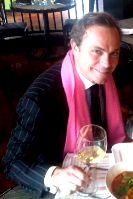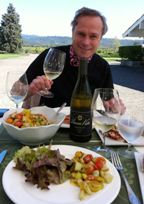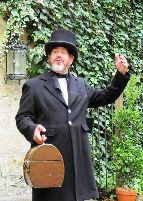 We had the opportunity during the 2012 Aspen Food and Wine Classic to sit down with the stylish and charming Jean-Charles Boisset of Boisset Family Estates. To refer to Jean-Charles, Wine Enthusiast Magazine 2009 Wine Innovator of the Year, as a “force of nature,” may be selling short his infectious enthusiasm accompanied by his passion for life and wine. Jean-Charles is a powerful blend of Old World sensibilities and New Word zeal.
We had the opportunity during the 2012 Aspen Food and Wine Classic to sit down with the stylish and charming Jean-Charles Boisset of Boisset Family Estates. To refer to Jean-Charles, Wine Enthusiast Magazine 2009 Wine Innovator of the Year, as a “force of nature,” may be selling short his infectious enthusiasm accompanied by his passion for life and wine. Jean-Charles is a powerful blend of Old World sensibilities and New Word zeal.
Born in Vougeot, in the heart of Burgundy to a winemaking family, Jean-Charles came to the U.S. as a teenager to complete high school. From there he obtained his undergraduate degree from the London Business School and his MBA from UCLA. It was during his MBA studies that he decided to expand his family’s French winery holdings to California. Today Boisset Family Estates is the largest Pinot Noir producer in Burgundy and the third largest winery operation in France. In California, they operate 11 wineries and labels including Raymond Vineyards, DeLoach Vineyards, Lyeth Estate, Lockwood Vineyard, JCB and Buena Vista Winery. History is integral to Boisset wineries both here and abroad. Most of their acquisitions have some viticulture historical significance. As Jean-Charles said “we are here to share together a unique moment, not be manufacturers of a beverage.
Today, Jean-Charles resides in Napa Valley with his wife, winemaker Gina Gallo, of Gallo Family Vineyards and their toddling twin daughters.
B&B Wine Blog: After being raised in the epicenter of the French wine world, why did you choose to make a life in America?
 JCB: In 1981 at 11, I was very fortunate to travel to the wine country and taste wine. I must confess I have been tasting wine since I was 7. I fell in love with this amazing country very early on. I always loved the US image, the American way of life and the dream of what America represents. I was very impressed with the wines of California. Strangely enough, the winery I went to visit at 11, though I did not taste in the tasting room with my grandparents, was Buena Vista. Back at our hotel we tasted the different Chardonnays from Buena Vista. My sister and I tasted and I said to her “those wines are amazing, wouldn’t it be fun one day to come back to California and make wine?”
JCB: In 1981 at 11, I was very fortunate to travel to the wine country and taste wine. I must confess I have been tasting wine since I was 7. I fell in love with this amazing country very early on. I always loved the US image, the American way of life and the dream of what America represents. I was very impressed with the wines of California. Strangely enough, the winery I went to visit at 11, though I did not taste in the tasting room with my grandparents, was Buena Vista. Back at our hotel we tasted the different Chardonnays from Buena Vista. My sister and I tasted and I said to her “those wines are amazing, wouldn’t it be fun one day to come back to California and make wine?”
So I’ve been intrigued and passionate about wine. I really loved the lifestyle of the US, the energy, the dynamism, the people and it really motivated me to come back and be in the wine world here. I’ve never looked back; there has never been a hesitation to have a life between the U.S. and France. The two nations, if you could combine them culturally, would be the perfect match because America is energetic, dynamic and always questioning how to do things better. France is very anchored and culturally very driven. The people of both countries do very well together.
B&B Wine Blog: Rumor has it that you intend to blend these two cultures in the barrel by offering a blend of Russian River Pinot Noir and Pinot Noir from Burgundy.
JCB: Oh my…how did you hear that, you must have a private investigator (laughing). There are many things that make our cultures fantastic together and one of those is wine. From a terrior perspective, and I’m speaking about Pinot Noir, it is the earthiness, the austerity, the seriousness as well as the primary flavors of Burgundy combined with the exuberance, the flamboyant fruit and the openness of the style of California Pinot, specifically Russian River, makes a phenomenal combination.
We finally came up with a blend that will be released very soon, a blend of Russian River and Côte de Nuits, Burgundy. It’s so out of this world that some people will say, you’re crazy, you are insane, and you are disrespectful. But when they taste it, I can tell you they will think 1+1= 3. It is all about the pleasure from the texture to the aromatic expression, to the phenolics of the wine, to the mouth-feel. You literally have a sensation of the two worlds.
B&B Wine Blog: Wineries with a historical significance play an important role in your acquisitions, why?
JCB: We feel that wine has been an integral part of civilization. It is an elixir of the gods that was given to us over 20 centuries ago. We feel it is very important to respect the past and take in the energy around creating wine with some of our properties like Buena Vista, opened in 1857, and some of our finest vineyards in Burgundy that were created in the 1100’s. We feel that many people have done a wonderful job in the past and we should recognize it. We should keep it alive, restore it and take it to the next generation. This is very true of our California portfolio; De Loach was one of the first to plant Pinot Noir in Russian River, Lyeth Estate was the first to create Bordeaux blends in Alexander Valley, Raymond – five generations of winemakers in Napa and one of the first to be established in Rutherford. Our latest favorite, Buena Vista, was really the founder of modern California viticulture in 1857. Each of these places has attracted us because something unique has happened there…I can go on and on.
We see ourselves as safe guarders of history, as protectors for the generations to come. We want to keep history alive and communicate it to the rest of the world. That is why at Buena Vista we are writing a book with Charles Sullivan about the history of Sonoma through the eyes of Buena Vista. Many wines around the world are great, what is fabulous is to be able to share a unique story.
B&B Wine Blog: With history and unique stories, what can a visitor to one of your wineries expect?
JCB: We want people to have fun, enjoy the wines but also learn in terms of viticulture, winemaking and history. They will get a sense of place and also learn about themselves because when you taste wine you also learn about yourself. It is so important to take it seriously and engage people at every level. So in every winery we respect very much the founder and family members. Many of our wineries still have family members working there. We want that continuity because it is very powerful.
B&B Wine Blog: Buena Vista certainly ranks as one of the most historic California wineries. How are you respecting its past?
JCB: The Count of Buena Vista, Agoston Haraszthy, came to the US in 1857 daring to build the largest estate, 500 vineyard acres, the longest vaults, the first gravity flow winery in Sonoma in what was those days 4 or 5 hours from San Francisco. He was the first to bring Zinfandel to California from Italy. Can you imagine the guts it took to do that, to that magnitude? We’d be crazy and arrogant to try to erase the past. There is nothing more interesting to explain than this winery is over 150 years old…people listen and are interested. We see the Count as an explorer and a pioneer and we need to continue this at Buena Vista.
We want to excite our guests a little differently than; here taste my wine. So we brought back the Count of Buena Vista with the actor/historian George Webber (See The Count’s Video). We want people to talk with him, ask questions and go back to the 19th century and discover that this is a country with a lot of content in its past. We want people to understand that the wine world in California did not begin in 1976. Buena Vista began in 1857, Russian River vineyards date to 1812 and the missions from the 1770’s. We want to communicate that America has a great identity in wine.
In addition, we are very actively creating a bond with the Count and Hungary, where he was from, and Sonoma. We are working to associate Sonoma with the historical vineyards of Tokaji which is a big deal because Tokaji was the wines of the kings and queens in those days. Also, we have asked the University of Hungary in Tokaji to provide us with two of the historical vines which date to 1680 when they were originally planted and yes, they have agreed.
B&B Wine Blog: What efforts are you making to restore the building to its past grandeur?
JCB: We are renovating the entire building and site. (Photos of the restoration) But most importantly beginning in September we will once again be making wine in the most historic cellars in California. In those days they called it, the vaults. It is a gorgeous stone gravity flow building. We will be making wines in open top oval oak tanks. It is very important to us that people see us making wine in those historic cellars.
We will be creating a fascinating dialogue with our guests with a historical tour about the history of the state of California, the history of viticulture, the history of Buena Vista and we will ultimately bring a museum from France to the winery as well. It will be a destination. We will create an amazing visual identify and physical presence in Sonoma.
B&B Wine Blog: What can we expect from the Buena Vista wine program under your stewardship?
JCB: Of course, wine is honestly what we love to do the most. We want to make wines that are flamboyant, exciting and really inspiring. We brought in David Ramey (Chalk Hill, Matanzas Creek, Dominus Estate (owned by Christian Moueix, of Pétrus), Rudd Estate and Ramey Cellars) as the consulting winemaker to make an amazing wine program, really amazing. We cannot own the most historical winery in CA and not make the most interesting wines.
We have created a very interesting range of Sonoma wines from Chardonnay, Pinot Noir, Merlot and Zinfandel which was no longer planted at Buena Vista which is crazy. We created a Private Reserve tier, very sexy and intellectual wines. Then we created the Vinicultural Society tier named for a society created in 1863 and was the first shared corporation for wine in America and one of the first in the world. Those wines will consist of 25 to 75 case lots of things we love and we are just passionate about. We want you to come to Buena Vista and be enchanted and dream about varieties you might not typically taste. With that in mind we created a unique range of ports, sherries and cream sherries which was very popular at Buena Vista in the past.
B&B Wine Blog: Can you speak to the new style of Buena Vista wines?
We like to think that we create unique wines stylistically at each of our wineries. Beyond terrior driven wines, we want Buena Vista wines to be extremely soft, extremely elegant and very eloquent. We could have gone with very big or exotic wines but we have gone in the opposite direction. Our white wines will have a lot of minerality and acidity. Our Sonoma Chardonnay will almost be in line with Chablis from Burgundy. These are wines that could have been made in those days with some oak influence, but quite minimal. We want subtly, we want refinement, and we want finesse. We want a sense of exuberance in our red blend, called the Count. The Proprietors Reserve will have a lot of spice on the finish, well-balanced with intensity and subtle tannins. For the rest of the lines it is very important that the wines are not too alcoholic and not too big but very seductive. The wines will have a European instinct with a California allure.
We will be making many unique varieties in 20 – 30 case lots that you will say, really are you going to try that, are you insane? The wines will be less vineyard-driven and more variety-driven unlike DeLoach.
You will be able to go into one of the Vinicultural Society tasting rooms and taste obscure varieties and have a blast with it. It will be a playground for people who love wine.

They are an astounding and historical business enterprise, and a quite successful one obviously. I am familiar with and enjoy some of their California products; they have been consistent from year to year, some even at very reasonable prices, and others well worth the premium. A magical group of offerings!
Interesting interview. I have to say that I have a problem with some JPB’s take on American wine history. In particular, JPB’s contention that Haraszthy introduced Zinfandel from Italy is false. This is a myth that has been disproven many times. I refer you to Charles Sullivans book “Zinfandel”. There were a number of introductions of Zinfandel, or Black St. Peter, as it was called, but none of them by Haraszthy. The grape had actually arrived in California before Haraszthy. It is a shame that misinformation like this continues to be propagated in the fields of wine marketing.
Very interesting since Sullivan is writing the book on Buena Vista….
Yes, Charles is writing a book that will include the history of Buena Vista, that is comissioned by Buena Vista, but will mostly be about the history of grape growing and winemaking in Sonoma. The Beuna Vista story is a relatively minor fraction of that. It seems likely that the Zinfandel question will be addressed. Charles has made the Zin history fairly transparent in his other books. Thomas Phinney has also chimed in on the Zinfandel subject. He and Charles seem to agree that Haraszthy was not the source of Zinfandel in California.
Thanks for setting the record straight… Zin Master!
Very interesting interview. Will be interesting to see what happens… was and still am a big fan of some of thes brands (Ex. DeLoach and Buena Vista) although its harder and harder to find a “value” wine here. It will be interesting to see how he shapes the overalll brand/strategy/marketing/PRICE
It was a really fascinating interview… I hope I was able to capture the passion Jean-Charles exudes